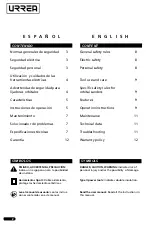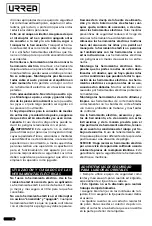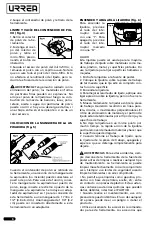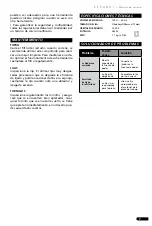
10
ATTACHING THE SANDPAPER (fig 1)
1. Unplug the sand-
er.
2. Disengage the
sandpaper clamp
by pushing the wire
clamp on the side
of the sanding pad
towards the sander
body.
3. Line up the edge of the sandpaper with the
edge of the sanding pad. Insert the sandpaper
under the clamp. To lock the sandpaper in place,
engage the clamp.
4. Disengage the clamp on the other side of the
sander. Stretch the sandpaper tightly over the
foam pad and insert the outer edge under the
clamp at the rear of the sander.
5. Align the edge of the sandpaper with the
edge of the sanding pad. To lock the sandpaper
in place, engage the clamp.
NOTICE: Before attaching a new sanding sheet,
remove any dust or debris from the sanding pad.
IMPORTANT: Never connect the sander to
the power source when you are assembling
parts, making adjustments, installing or remov-
ing sandpaper, cleaning, or when it is not in use.
Disconnecting the sander will prevent acciden-
tal starting, which could cause serious personal
injury.
USING THE PUNCH PLATE (fig 2)
After the sandpaper
has been clamped
to the sanding pad,
use the punch plate
to punch the vac-
uum holes into the
sheet.
1. Align the punch
plate with the sanding pad and push down on
the sander until the punch plate pierces the
sandpaper.
2. Remove the punch plate from the sanding
pad.
DUST CANISTER (fig 3)
Your sander is
supplied with a
dust canister to
help you keep
the working area
clean. The dust
canister is ideal for
smaller jobs. For
maximum efficiency, the dust canister should be
emptied frequently during operation.
To install:
1. Disconnect the sander from the power source.
2. Align the slot on the dust canister with the
rib on the tool, and then push the dust canister
onto the tool until it locks into place.
To remove:
1. Disconnect the sander from the power source.
2. Pull the dust canister out and away from the
tool.
CLEANING AND EMPTYING THE DUST CAN-
ISTER (fig 4)
1. Remove the dust
canister from the
tool.
2. Holding the
dust-canister body,
press the release
button to free the
microfilter. Pull the
microfilter from the dust canister.
3. Knock excess dust out of the microfilter, or re-
move dust with a soft brush. You may noticethat
all the dust may not come out of the microfilter.
This will not affect sanding performance but
will reduce dust collection efficiency.
ATTACHING VACUUM HOSE (fig 5)
When the dust canister is removed from the tool,
a vacuum hose accessory (available separately)
can be attached to the dust port. To use this fea-
ture, attach the vacuum hose to the dust port,
then connect the opposite end of the vacuum
hose to a shop vacuum cleaner. A 2-in-1 vacuum
adaptor is included for connection of this tool to
a 1 7/8 or 2 1/2” (4.8 or 6.4 cm) vacuum hose. A
1 1/4” (3.2 cm) vacuum hose may be connected
directly to the tool without an adaptor.
TURNING THE
SANDER ON/OFF
(fig 6)
To turn on the
sander, depress the
side of the rocker
switch marked “I”.






























